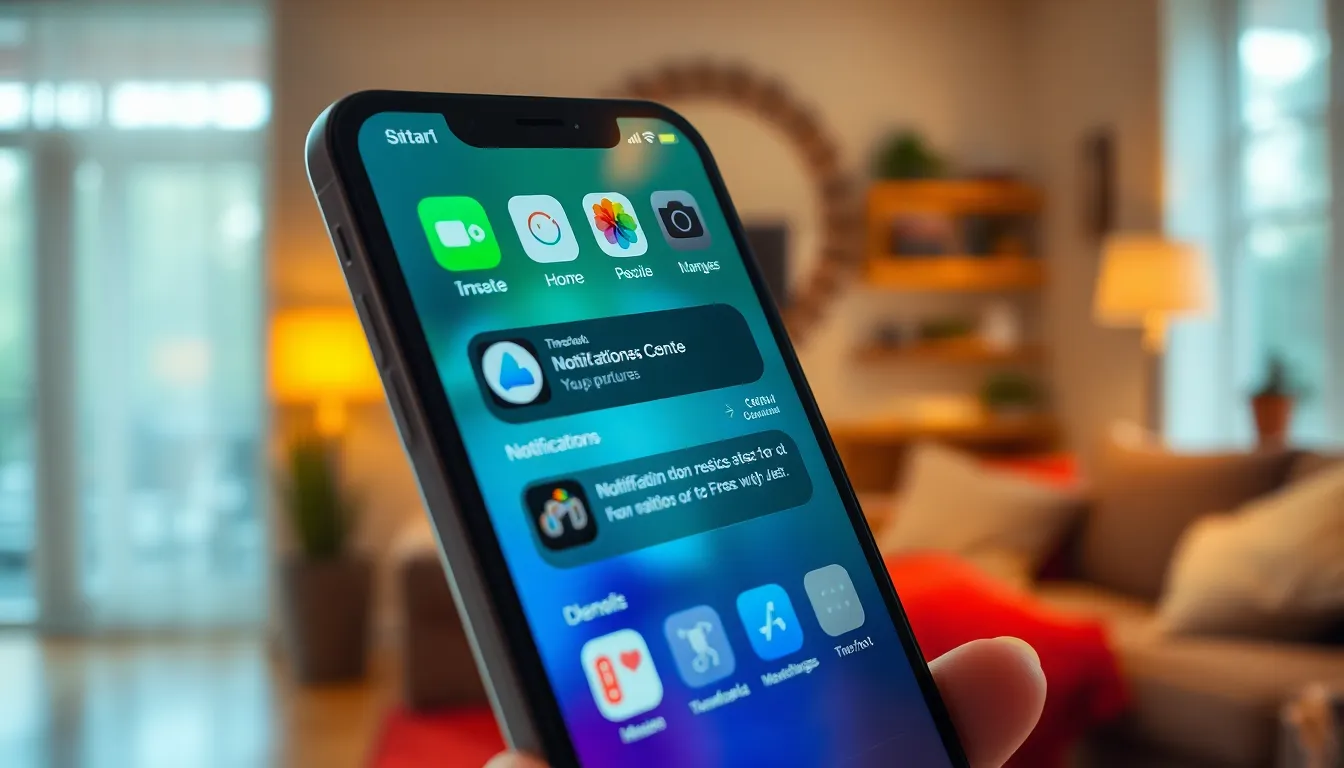In a world where notifications pop up like popcorn in a microwave, keeping track of them can feel like a full-time job. Between social media alerts, app updates, and those pesky reminders, it’s easy to miss something important. But fear not! Checking all your notifications on an iPhone is simpler than finding a cat video on the internet.
Table of Contents
ToggleUnderstanding Notifications on iPhone
Notifications serve as alerts to keep users informed about apps, messages, and events. They play a crucial role in managing tasks and communications effectively.
Types of Notifications
Notifications on iPhone come in various formats. Banner notifications display at the top of the screen and disappear after a few seconds. Alerts require direct interaction, prompting users to take action. Badge notifications appear as small red dots on app icons, indicating unread messages or updates. Additionally, sound notifications play specific tones to grab attention. Different types allow users to prioritize what matters most.
Importance of Managing Notifications
Managing notifications enhances user experience and productivity. With countless alerts, disorganization can easily occur, leading to missed information. Customizing notification settings ensures users receive only relevant updates. Optimal management reduces distraction and fosters focus, contributing to better engagement with essential tasks. Prioritizing notifications prevents overload, allowing for clearer communication with friends and work. Providing control over notifications promotes a personalized approach to device usage.
How to Access Notifications

Accessing notifications on an iPhone enhances user organization and awareness. Users can find relevant alerts quickly through straightforward methods.
Using the Notification Center
Swipe down from the top of the screen to open the Notification Center. This feature displays all recent notifications from various apps. Each notification includes the app icon for easy identification. Additionally, users can view notifications grouped by app or by time. Tapping on a notification opens the respective app for further details. Users can also clear notifications by swiping left, providing immediate tidiness to their interface.
Utilizing Lock Screen Notifications
Lock screen notifications offer quick visibility for important alerts. Notifications appear when the screen is locked, allowing users to read messages and updates without unlocking the phone. Users can customize which notifications display on the lock screen through settings, prioritizing essential alerts over less relevant ones. Swiping left on a notification allows immediate interaction or dismissal. A simple tap unlocks the device, granting access to the app related to the notification. Adjusting these settings ensures users only receive critical updates, enabling focus and reducing distractions.
Managing Notification Settings
Managing notification settings on an iPhone promotes a streamlined user experience. Customization options allow users to tailor alerts based on personal preferences.
Customizing Notification Preferences
Users can modify notification preferences easily. They access these settings by opening the Settings app, then selecting Notifications. Here, options for each app appear, enabling users to control alert styles, sounds, and badges. Users may choose to receive banner notifications for some apps while opting for sounds from others. Important notifications deserve priority, so users may want to enable previews for apps related to messaging or scheduling. Additionally, users can decide whether notifications appear on the lock screen, keeping essential alerts visible for quick access.
Turning Off Unwanted Notifications
Many users face notification overload. To combat this, individuals can turn off unwanted notifications for specific apps. Navigating to the Notifications settings within the Settings app makes this process simple. A tap on the desired app reveals options to adjust settings. Users can toggle off Allow Notifications for apps that aren’t critical. This step significantly reduces distractions, allowing individuals to focus on what matters most. Frequent notifications from social media or less important apps often lead to missed alerts from essential contacts or services. Prioritizing notifications enhances communication efficiency and overall productivity.
Advanced Notification Features
Advanced notification features enhance how users receive and manage alerts on an iPhone. Grouping and summarizing notifications play key roles in maintaining organization and prioritization.
Grouping Notifications
Grouping notifications consolidates alerts from the same app, making it easier for users to stay informed. It allows multiple notifications to appear together in the Notification Center, reducing visual clutter. Notifications can be organized by app or by time, which helps users quickly find what’s most important. Users can adjust settings to customize how notifications are grouped, allowing for a more streamlined view. For example, managing notification grouping can effectively highlight messages and reminders, ensuring they aren’t overlooked.
Notification Summary
A notification summary provides users with a curated collection of alerts. Summaries are available at scheduled intervals, highlighting critical notifications while suppressing less important ones. Users can enable this feature in the Settings app, which conserves attention by minimizing distractions. By reviewing this summary, individuals can easily catch up on missed notifications without the need to scroll through the Notification Center. For instance, summaries can include app alerts and calendar reminders, prioritizing events and activities that require immediate attention.
Managing notifications on an iPhone is essential for maintaining focus and productivity. By understanding the different types of notifications and utilizing features like the Notification Center and lock screen alerts, users can streamline their digital experience. Customizing notification settings allows individuals to prioritize what truly matters, reducing distractions from less important alerts.
With tools like grouping and notification summaries, users can efficiently catch up on missed notifications while keeping their screens organized. By adopting these strategies, they can enhance communication efficiency and create a more personalized device experience. Embracing effective notification management ultimately leads to a clearer mind and improved overall productivity.


